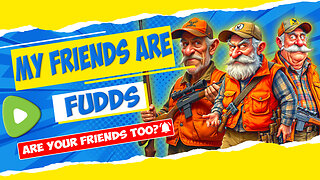Premium Only Content

Dog got emotional after death of his master
If you love them or have one in your life, then you already know dogs experience a wide range of emotions. This is obvious to most pet owners, and yet there may be even more going on than you realize. While they seem silly — and even perpetually happy — at times, dogs have a lot going on inside. And being able to recognize all their feelings can help you feel closer.
"When we understand how complex and rich our dog’s emotional lives are, we’re more compassionate and patient," Kayla Fratt, certified dog behavior consultant at Journey Dog Training, tells Bustle. If your dog is anxious, afraid, or frustrated, for example, recognizing the emotion can go a long way in helping them feel better.
Of course, we still don't understand exactly what dogs are thinking. "We can look at their behaviors and even scan their brains, but we can’t be 100 percent sure how that behavior or brain scan correlates to a feeling," Fratt says. "That said, we still can know quite a bit [...] We’re pretty sure that dogs can feel emotions like fear, frustration, anxiety, joy, relaxation, and anticipation. These line up pretty well with the Eight Core Emotions," which humans experience as well.
Dogs definitely experience a lot of feelings, including ones we can see displayed on the outside through their body language. Here are their many emotions, and what it all might look like, according to experts.
1
Fear
Matt Cardy/Getty Images News/Getty Images
While many dogs come off as super brave, as they bark out windows and jump up on strangers, they are actually perfectly capable of feeling fear.
"Fear is one of the most ancient emotions, because without fear, animals are less likely to change their behavior in a way that saves their lives," Fratt says. "No fear often leads to danger, which leads to no offspring." So this is one emotion that's actually incredibly useful to them.
And when you know what to look for, it's also easy to spot. As Fratt says, "Dogs display fearful postures such as tucking their tail, pinning their ears back, rolling on their backs, shifting their weight backwards, or even defensive aggression like snarling, snapping, and lunging."
2
Frustration
Sandra Mu/Getty Images Entertainment/Getty Images
Just like us humans, dogs can feel the annoying sensation of frustration. And with it comes a whole host of behaviors, such as barking, whining, and pacing. "This is really common in dogs that don’t know how to 'ask politely' for something and don’t know how to get what they want," Fratt says.
If they don't know to stand by the backdoor in order to be let outside to pee, for example, your dog might whine or pace instead, as a sign of their frustration.
"Clear communication with your dog (if you do this, I’ll give you that) is one of the best ways to reduce frustration," Fratt says.
3
Anxiety
Chris Jackson/Getty Images Entertainment/Getty Images
Sadly, dogs can experience anxiety, especially if they had a traumatic past.
"Dogs that are anxious cannot relax or take a long time to relax after a relatively minor disturbance," Fratt says. "Dogs that are anxious often pant with their lips pulled far back, their eyes are wide, [and] their ears are pulled back or swiveling."
They also may pace around, have dilated pupils, or fall asleep at weird times as a way of dealing with their anxiety, Fratt says.
If you notice these behaviors in your dog, let a vet know. There are lots of ways dogs with anxiety can feel better.
4
Joy
Veronika 7833/Shutterstock
When you arrive home after a long day, and your dog is happy to see you, that's true, bonafide joy you're witnessing. (Not that you couldn't have guessed.)
"Of course, this is our favorite emotion to see," Fratt says. "Dogs feeling joy pounce, prance, and huff happily (that little huh-huh panting sound is sometimes called canine laughter)."
It's easy to spot a joyful dog, and know that they're feeling happy. "It makes you smile," Fratt says.
5
Relaxed
Ben Pruchnie/Getty Images News/Getty Images
Whenever your dog's kickin' it on the couch, that's a sign they're enjoying a moment of deep relaxation.
"Dogs that are relaxed (or relaxing) may sigh, roll over onto a hip while they’re lying down, and stretch," Fratt says. "Relaxed dogs may sleep fully stretched out — they’re comfortable enough to take up some space!"
These are all signs your dog is feeling safe and secure, and is able to truly relax as a result.
6
Anticipation
Adam Berry/Getty Images News/Getty Images
Take one look at a dog that's waiting to go on a walk, and you'll know they are able to feel heaps of anticipation.
As Fratt says, "The most obvious instances of anticipation can be seen when dogs know that they’re about to get to play. They may prance happily, whine, or freeze. It will really vary from dog to dog!"
Every dog is different, so all these emotions can play out in unique ways depending on their personality, temperament, and breed. But in most cases, happy anticipation is easy to spot.
7
Love/Attachment
Christin Lola/Shutterstock
Even though our knowledge is currently limited, there is evidence to suggest — and plenty of real-life stories — that reveal a dog's ability to love.
"Oxytocin being produced by dogs and their owners has now been confirmed to increase with positive interaction," dog trainer Jodi Cassell, MS, CTC, tells Bustle. "I would say that we can say right now that dogs experience attachment (call it love if you will) and joy."
One way to know if a dog's feeling the love, is by looking out for signs of comfort. "We can do something called a 'consent test' where, if the dog approaches, we can pet him for a couple seconds and then pause and give him time to respond," Cassell says. "If he moves closer, shows relaxed body language, and/or leans into you, that’s a great sign that he is enjoying the interaction and wants more."
8
Surprise
Diana Baliuk/Shutterstock
Similar to joy, surprise is another emotion you may spot when you return home.
"Ever see a dog jump and spin when they see their human parent again after a long time apart? Or see their four-legged best friend? These dogs are surprised, and their body-language tells you so right away," Robert Cabral, Wag! advisory board member and top dog trainer, tells Bustle. "They go from calm to hyper-happy in a blink of an eye."
9
Jealousy
Jamie McCarthy/Getty Images Entertainment/Getty Images
While a dog may not feel jealousy in the exact same way humans do, they definitely display jealous-like behaviors.
"Dogs can be jealous over a number of things, but a more common and collective term for this would be 'resource guarding,'" dog behaviorist Nick Jones, MA, tells Bustle. "This in essence is the desire to keep something for itself, such as a bone, a bed, a toy, the owner — the list is long."
And this can play out in a number of ways, "such as aggressive behavior (varying from a grumble to an attack) in an effort to deter the dog or person that might be threatening the dog's perceived prize or possession, be it a bone, a toy or the owner," Jonas says. "Alternatively, the dog may hoard or hide a physical item so as to keep it to themselves."
Basically, jealousy is more like possessiveness, when it comes to dogs.
10
Depression/Sadness
Koichi Kamoshida/Getty Images News/Getty Images
"Like people, dogs have the ability to experience feelings of contentment, whereby all their needs are met and they feel a natural balance inside on an emotional level," Jonas says. And they can also feel sad, just like us, when their needs aren't being met.
"Although dogs can't rationalize these reasons for feeling depressed as you or I might, they sense the change and this can be displayed in ways that we would term as 'depressive behavior,'" he says. "A dog that is depressed may sleep more, show signs of being withdrawn, [and] may exhibit new behaviors such as barking at night or when left alone."
11
Loneliness
Drew Angerer/Getty Images News/Getty Images
While dogs should be able to withstand being left alone for periods of time without acting out, some dogs are prone to feeling lonelier than others. And if they're feeling this way, they'll let you know.
If your dog is lonely, they might try "barking or howling when left alone, [or] may also become destructive due to increased stress levels," Jonas says. If you aren't sure how to make your dog feel better, don't hesitate to ask a vet.
Dogs certainly have emotions, as well as a complex inner world we're only beginning to uncover. And they do their best to communicate what they're thinking.
By knowing what to look for — in the form of certain behaviors that help reveal what's going on inside their cute heads — you can begin to understand your dog that much more.
-
 19:51
19:51
Robbi On The Record
21 hours agoElectronic Tattoos Measuring Thoughts? From iPhone to iSkin
11.6K13 -
 LIVE
LIVE
The Mel K Show
3 hours agoMel K & George Papadopoulos | Deep State Targets Rising: The Geopolitical Reality of Spy Gate | 9-5-25
442 watching -
 LIVE
LIVE
SavageJayGatsby
21 hours agoLet's Play: Sea of Thieves | Friend Friday
35 watching -
 LIVE
LIVE
LFA TV
13 hours agoLFA TV ALL DAY STREAM - FRIDAY 9/5/25
723 watching -
 1:08:51
1:08:51
BonginoReport
9 hours agoMass Migration And The Erasure Of British Culture w/ Ian Haworth - Hayley Caronia (Ep.128)
88K30 -
 2:15:11
2:15:11
MattMorseTV
5 hours ago $12.71 earned🔴Trump's MASSIVE Oval Office ANNOUNCEMENT.🔴
36.8K47 -
 3:52:41
3:52:41
Nerdrotic
5 hours ago $8.90 earnedUK Has Fallen, Hollywood DOOM, DC Dysfunction | Friday Night Tights 370
72.3K9 -
 5:52:26
5:52:26
Dr Disrespect
9 hours ago🔴LIVE - DR DISRESPECT - CRONOS: The New Dawn - FIRST IMPRESSIONS
106K13 -
 1:30:44
1:30:44
Roseanne Barr
7 hours agoOn the Wrong Side of the Algorithm | The Roseanne Barr Podcast #114
98.7K50 -
 13:53
13:53
TundraTactical
5 hours ago $1.64 earnedFudd Finder : 11 Questions Second Amendment Questions (And Roasts) to Ask Your Friends
32.9K1